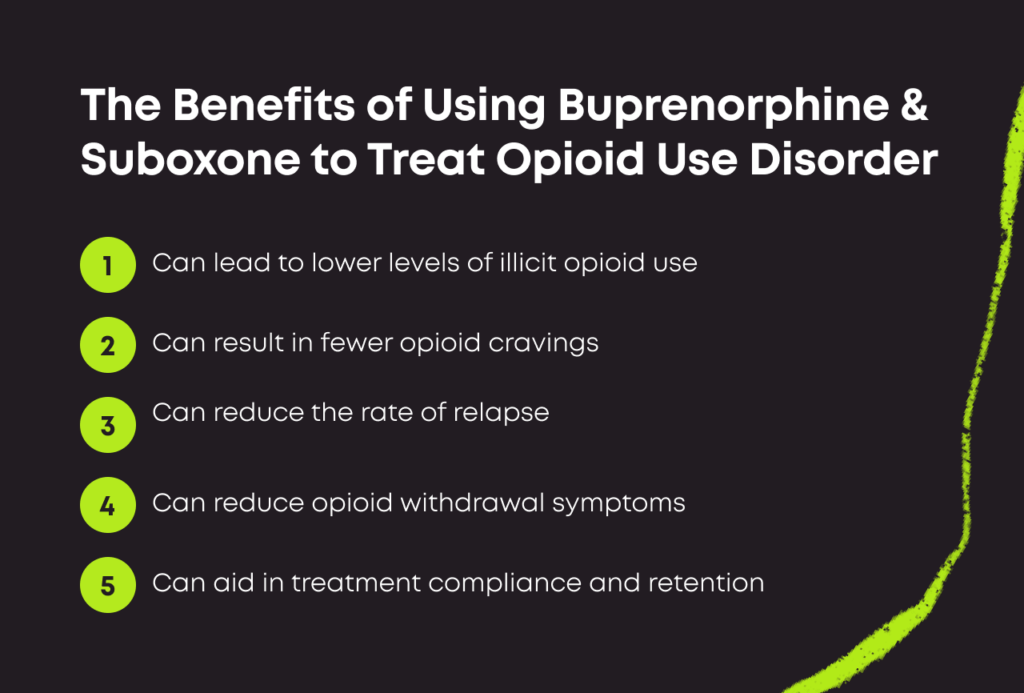Buprenorphine and Suboxone are medications doctors use to treat opioid use disorder (OUD). They work by reducing withdrawal symptoms and ongoing drug cravings.
Buprenorphine is an ingredient in Suboxone, so the two medications are very similar. But important differences separate them. It’s important to understand these options, so you can choose the right OUD therapy for you in conjunction with your doctor’s advice.
Understanding How Buprenorphine & Suboxone Work
Buprenorphine and Suboxone are types of Medication for Addiction Treatment (MAT), which are approved by the FDA to treat OUD. Several types of buprenorphine medications exist, and they all have a slightly different composition.
How Do These MAT Options Work?
Buprenorphine is a partial opioid agonist. It latches to receptors used by stronger drugs like heroin, blocking illicit drugs from working, reducing cravings and easing withdrawal symptoms.[1]
Suboxone contains buprenorphine and a second ingredient, naloxone. The naloxone in Suboxone is inert unless users take too much or misuse their doses. If they do, this ingredient kicks in and lowers overdose risks.[2] For people using Suboxone as directed, they may only notice the buprenorphine.
Buprenorphine & Suboxone: A Comparison
While buprenorphine and Suboxone are very similar, important differences separate them. This table makes their similarities and differences clear:
| Buprenorphine | Suboxone | |
| Ingredients | Buprenorphine | Buprenorphine and naloxone |
| Drug class | Partial opioid agonist | Partial opioid agonist and opioid antagonist |
| Use to treat | Opioid use disorder and opioid withdrawal symptoms | Opioid use disorder and opioid withdrawal symptoms |
| Brand name | Sublocade | Suboxone |
| Works by | Reducing withdrawal symptoms and cravings | Reducing withdrawal symptoms and cravings |
| Potential for misuse | Can be misused | Lower potential for misuse due to naloxone |
| Safety | Generally safe | Even safer than buprenorphine due to the naloxone |
| Formulations | Tablets and extended-release injection | Tablets or strips |

Benefits of Using Buprenorphine & Suboxone to Treat OUD
Both Suboxone and buprenorphine are effective medications for helping to maintain recovery from OUD. They have the following benefits:[1]
- Fewer opioid cravings
- Lower levels of illicit opioid use
- Reduced rate of relapse
- Fewer and less severe opioid withdrawal symptoms
- Better treatment compliance and retention
Suboxone contains naloxone, which is a safety mechanism. If you think there is a risk that you might dissolve and inject your buprenorphine, you should use Suboxone.
The injectable form of buprenorphine (Sublocade) offers the added benefit of being an extended-release formulation that only needs to be taken once per month. It is also safe to take during pregnancy and for those who have a rare reaction to naloxone.
Depending on your insurance, Suboxone may be covered when pure buprenorphine is not covered, or vice versa. Many people use the medication their insurance will cover.
Is One More Effective Than Another?
There is little evidence confirming one medication is more effective than the other. Both buprenorphine and Suboxone, when taken as prescribed, can help people quit misusing opioids and achieve long-term abstinence and recovery.
For people with allergies to naloxone, a pure form of buprenorphine is the best choice. And for those who don’t want to take a daily dose of medications, injectable buprenorphine with Sublocade could be a great option.
Suboxone is generally considered a safer choice than buprenorphine, as it contains naloxone as a misuse deterrent. You won’t be able to do things like crush your doses and inject them. If you’re worried about misusing your medication, Suboxone is safer.
Key Differences Between Buprenorphine & Suboxone
Important differences between these two medications exist, including some that might prompt you to choose one MAT option over the other.
Key differences include the following:
- Ingredients: Buprenorphine is a standalone medication, while Suboxone contains both buprenorphine and naloxone.
- Misuse potential: Buprenorphine isn’t as strong as drugs like heroin, so it’s rarely misused by people with an OUD history. But some buprenorphine forms can be crushed and injected. Suboxone includes a misuse deterrent, naloxone, to ensure this doesn’t happen.
- Formulations: Suboxone is typically provided as dissolving strips. Buprenorphine is available in tablets and injections.
- Coverage: Generic buprenorphine may be less expensive than brand-name Suboxone. Your insurance may require you to pick one over the other.
How Bicycle Health Can Help With OUD
Bicycle Health offers Suboxone therapy to people with OUD. Visit with a professional in an online appointment, and pick up your prescription at a pharmacy near you. Connect with therapy through video appointments, so you can receive treatment no matter where you are.
Avoid the stigma associated with in-person appointments. And know that you can get the help you need whenever you need it.
Contact us to find out if this model is right for you.

Reviewed By Peter Manza, PhD
Peter Manza, PhD received his BA in Psychology and Biology from the University of Rochester and his PhD in Integrative Neuroscience at Stony Brook University. He is currently working as a research scientist in Washington, DC. His research focuses on the role ... Read More
- Buprenorphine. Substance Abuse and Mental Health Services Administration. Published September 18, 2023. Accessed October 18, 2023. https://www.samhsa.gov/medications-substance-use-disorders/medications-counseling-related-conditions/buprenorphine
- Suboxone prescribing information. U.S. Food and Drug Administration. Published March 2021. Accessed October 18, 2023. https://www.accessdata.fda.gov/drugsatfda_docs/label/2021/022410s042lbl.pdf
Download Our Free Program Guide
Learn about our program, its effectiveness and what to expect
Imagine what’s possible on the other side of opioid use disorder.
Our science-backed approach boasts 95% of patients reporting no withdrawal symptoms at 7 days. We can help you achieve easier days and a happier future.